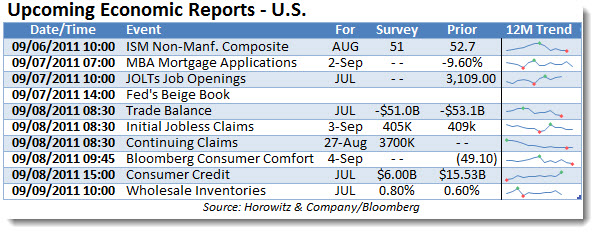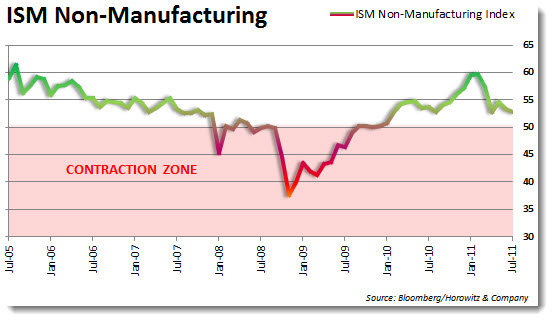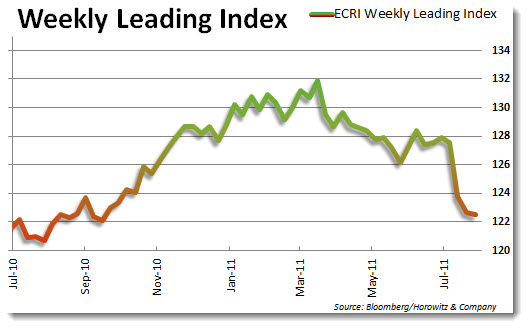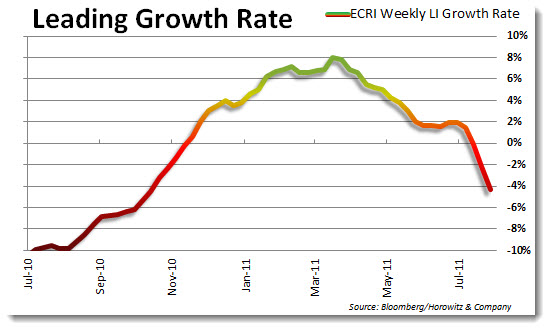During the month of September, we are going to be adding a special section to this site.
The TDI Managed Growth Strategy provides a private “client-only” blog where we discuss the day and our general outlook. Areas that we cover range from current holdings analysis, economic reports, political commentary and more.
The primary purpose of the “client-only” blog is provide information so that clients for whom we manage money will have a better understanding of what is the rationale for portfolio decisions. In addition, the information is designed to be educational so that readers can learn from both our mistakes and successes.
On a daily basis, simply follow www.thedisciplinedinvestor.com or use an RSS reader and point it to : http://tinyurl.com/3u3jahy or http://www.thedisciplinedinvestor.com/blog/category/stocks/insideedition/feed/
___
2011-09-05
(CLICK HERE FOR LAST WEEK’S UPDATE)
U.S. markets are closed in observance of the Labor Day holiday. But this does not mean that world finance stops. Major markets around the world are open and will be reacting to the ZERO increase in payrolls that was released in Friday’s NFP report. Aside from coming in well below expectations, there were a few other items that were reported that were just as unnerving.
The first is the decline in hours worked. This shows that the manufacturing and productivity numbers that we have seen are not an aberration. The lack of manufacturing and declining confidence is due to more than simply a blip because of higher oil prices and EuroZone fears. If we take the media’s reports up until this point, most are providing quotes from economists and analysts that had said back in March that higher oil prices and the Japanese earthquakes would have little impact on the global growth story. These same folks are now using the terms “soft patch” and “transitory” to describe the current economic conditions. This is what it has come to once again…Hope and excuses, just like we saw a few short years ago.
These days investors are not buying it. Sell first and ask questions later is the new investment mantra as each piece of data (economics, political and earnings) pushes and pulls markets to the extreme. It is starting to look like amateur hour! Or perhaps it is actually the absence of amateurs and the presence of computer algorithms and high-frequency trading that is at the core of the ridiculous intraday swings.
(Listen to the latest TDI Podcast with guest, Frank Curzio —> Click Here )
Trading the news and what hedge funds call event based trading seem to be king at this stage as no one appears to be interested in the excess risk of holding overnight. As an example, inside of one day, there may be a report that shows that earnings for a bell-weather technology company beat earnings expectations and the market rallies 1% by 10am. Then at 10am an economic report is released that is disappointing and markets sell off and are down .50% by 11am. Around 1pm, a rumor circulates that a major European bank is having liquidity problems and by 2pm there is another .50% draw-down. Now, at 3pm, the European Bank rumor is squashed and a major brokerage firm upgrades GDP estimates. With a quick turn, investors buy all they can into the close, moving major indices up by 1% at the end of the day.
The more interesting part about all of this is that global indices appear to be dancing to the same song in tempo. As one exchange index moves, so do the others. In other words, the correlation across the global financial system is in almost perfect lock-step. As the U.S. has been a beneficiary of the maturation of developing nations, the interconnectedness of markets and economies has increased. That is terrific if all is going well around the world, but when it is not, everyone suffers.
Chaos Theory
 What is described could be thought of as a form of the “Butterfly Effect” which was popularized by Edward Lorenz in 1962. At that time, he realized that small differences in a dynamic system such as the atmosphere–or a model of the atmosphere–could trigger wide-ranging and often unsuspected results. His work eventually led him to formulate what became known as the butterfly effect–a term that grew out of an academic paper he presented in entitled: “Predictability: Does the Flap of a Butterfly’s Wings in Brazil Set Off a Tornado in Texas?”
What is described could be thought of as a form of the “Butterfly Effect” which was popularized by Edward Lorenz in 1962. At that time, he realized that small differences in a dynamic system such as the atmosphere–or a model of the atmosphere–could trigger wide-ranging and often unsuspected results. His work eventually led him to formulate what became known as the butterfly effect–a term that grew out of an academic paper he presented in entitled: “Predictability: Does the Flap of a Butterfly’s Wings in Brazil Set Off a Tornado in Texas?”
Now that banks in the U.S. rely on overnight lending with banks in France, small disturbances in either region creates unpredictable outcomes. Riots in Egypt have an effect on oil prices around the world and U.S. monetary policy changes will effect the economic landscape of Singapore. These are just a few examples to illustrate why we are seeing disruptions in U.S. markets that may have nothing to do with U.S. companies – on the surface.
If the Butterfly Effect has any truth to it, then this coming week will have some flapping winds creating quite a windstorm. Global economic data is going to be pouring out over the next few days and there are many important reports that we will be watching closely.
(Compilation of international and other important items that will surely move markets. (With help from Briefing.com)
Tuesday, September 6th
- U.S Congress returns from recess
- August ISM Services (10am)
- French & Italian Parliaments reconvene and could vote on EFSF (expected to pass)
- Italy’s largest union to strike
- Australia Interest Rate Decision (12:30am)
- Switzerland CPI (3:15am)
- Germany Factory Orders (6am)
- Canada PMI (10am)
- Australia Construction Index (6:30pm)
- U.K. Shop Price Index (7pm)
- Australia GDP, Home Loans (9:30pm)
- Conferences: German & Finnish Officials to meet on Collateral Issues
Wednesday, September 7th
- GOP Presidential Debate
- Germany Constitutional Court to rule on bailouts
- Spain to vote on budget deficit amendment
- Japan Interest Rate Decision
- Japan Leading Index (1am); U.K. Industrial & Manufacturing Production (4:30am)
- Germany Industrial Production (6am)
- Canada Housing Starts (8:15am)
- Canada Interest Rate Decision (9am)
- Australia Jobs Report (9:30pm)
Thursday, September 8th
- President Obama Economic Speech
- Finnish Prime Minister to make `economic matter’ announcement
- Switzerland Jobs Report (1:45am)
- Germany Trade Balance (2am)
- France Budget & Trade Balance (2:45am)
- U.K. Interest Rate Decision (7am)
- Greece GDP (TBD)
- ECB Interest Rate Decision (7:45am)
- Japan GDP- final (7:50pm)
- Australia Consumer Sentiment (8:30pm)
- Australia Business Confidence (9:30pm)
- China Fixed Asset Investment, Industrial Production, CPI, PPI, Retails Sales
Friday, September 9
- Japan Economic Survey (1am)
- France Jobs Report (1:30am)
- Japan Machine Tools (2am)
- France Industrial Production (2:45am)
- Italy Industrial Production (4am)
- U.K. PPI, Trade Balance (4:30am)
- Eurozone GDP (5am)
- Canada Jobs Report (7am)
- Conferences: G7 Finance Ministers Meeting
While there is a great deal on the international economic agenda, the U.S. docket is far less congested.
The two main reports that of the most significance are the ISM Non-Manufacturing and the Fed’s Beige Book. As consumers make up 70% or so of the U.S. economy, the ISM number will help show if there is a dislocation between manufacturing and the non-manufacturing reports.
For the most part, these ebb and flow with each other. But, there is still limited evidence that suggests that consumers have stopped spending. There is a great deal of “hope” resting on this report as many analysts still believe (even after HUGE declines in consumer confidence) that somehow consumers are continuing to spend. If this report gets to close or cuts under the 50 level, there will be a good deal of revisions to the U.S. growth outlook.
What should we expect to see? From all the information, there has been a rapid decline in consumer spending over the past two months. We have explored many reasons why this has happened in previous discussions. Perhaps the final measure that will prove to be the tipping point is the excess volatility we have observed in equities over the past few weeks. Trillions of dollars have been lost over the past six weeks in consumer wealth and this may show up negatively as going out to eat, shopping and other services are put on the back burner until people feel more confident about their financial future. Again, the tell is the low readings across all consumer sentiment reports.
As the monthly reports have already shown, the slowdown is more than a temporary blip. Looking at a more sensitive gauge a weekly reading also provides for a similar conclusion.
The growth rate of the Weekly Leading Index is designed to provide prompt, high-frequency signals of upcoming cyclical turns in the U.S. growth rate cycle. (This index is updated on a one week lag)
The index charted below is the smoothed annualized growth rate of the ECRI Weekly Leading Index. Again, this is showing a sharp decline from recent levels.
With all of this information at hand, we have few positions in TDIMG portfolios. Last week (Wednesday) several portfolio hedges were added as there were signals that flashed the potential for downside pressure that appeared imminent. That proved to be correct. Into the final hours of Friday’s trading day, portfolio positions were updated to include a couple of new names as well as a change to the total hedge positions that we are holding. More on the specifics of the changes/updates tomorrow.
For now, while the world contemplates the potential for the U.S. jobs market lack of recovery, there are few compelling reasons to be aggressively involved on the long side. At this juncture, a re-test of the August lows are the higher probability outcome. When/if those levels are either breached or rejected will be the time to pick a side with additional conviction.
Latest Podcast Episode: TDI Podcast 227: Futures 101, Cycles and Recession Forecasting (S&P@500?)
Guest(s): Professor Charles Nenner and Jon Markman
___




















